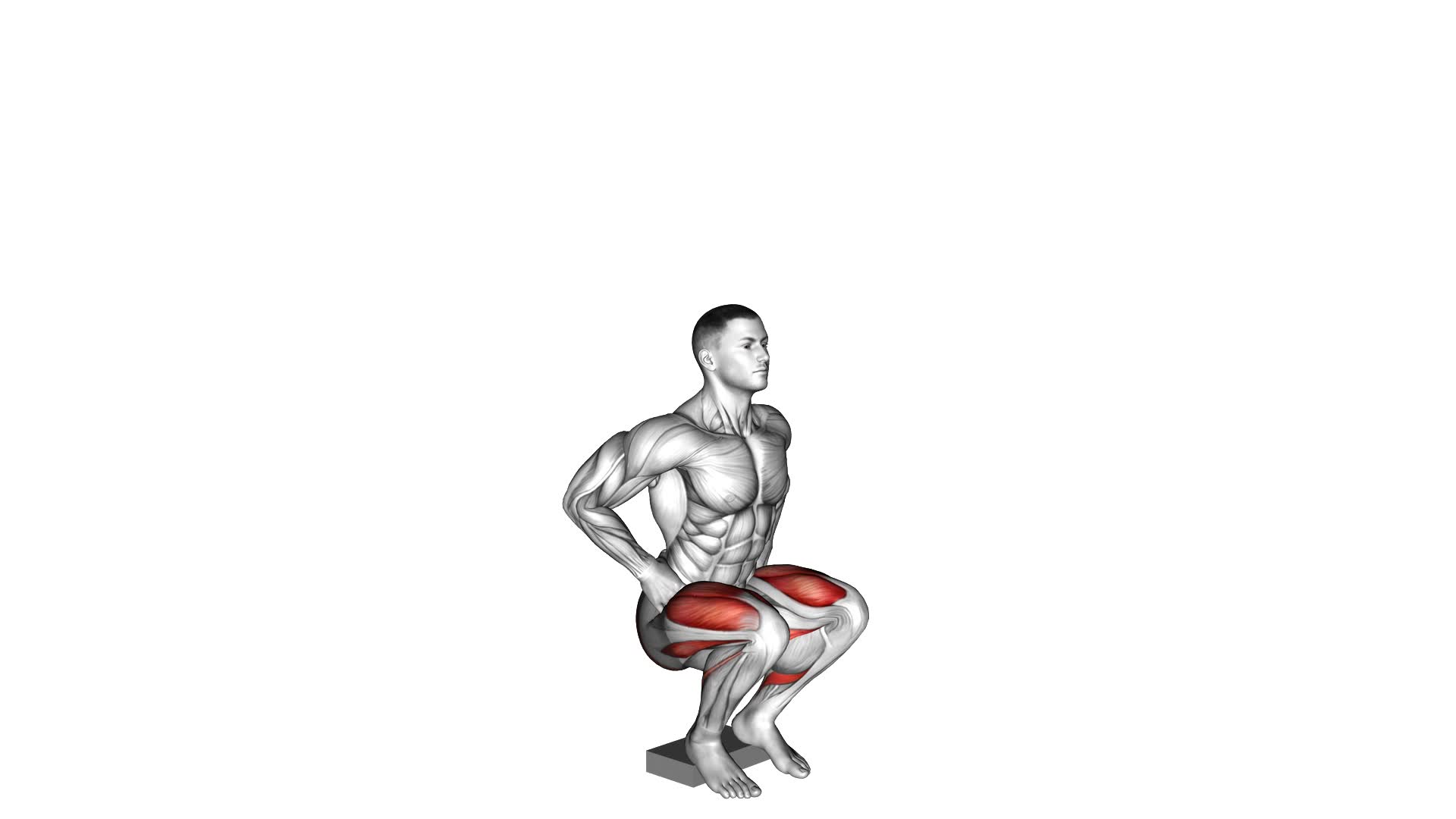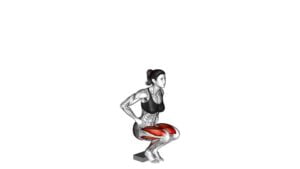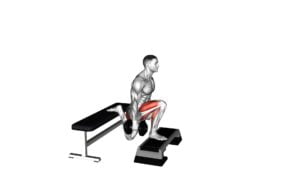Narrow Squat From Deficit – Video Exercise Guide & Tips

In this video exercise guide, you'll learn all about the narrow squat from deficit. Discover the benefits of this challenging exercise and get tips on proper form and technique.
Watch This Exercise Video
Learn how to avoid common mistakes and find out how to increase the difficulty and intensity. Explore variations and modifications to keep your workouts interesting.
Plus, don't forget safety precautions and warm-up exercises to ensure a successful narrow squat from deficit.
Let's get started!
Key Takeaways
- Increased muscle activation in quads, hamstrings, and glutes
- Greater range of motion and improved balance and stability
- Engagement of core muscles for a stronger midsection
- Improved flexibility and mobility in hips and ankles
Benefits of the Narrow Squat From Deficit
Experience the numerous benefits of the narrow squat from deficit. This variation of the squat exercise offers several advantages that can enhance your lower body strength and overall fitness.
One of the main benefits is increased muscle activation in the quads, hamstrings, and glutes. By placing your feet closer together in a narrow stance, you target these muscles more intensely, leading to greater strength gains.
Additionally, the deficit aspect of this exercise, where you stand on a platform or plates, increases the range of motion and challenges your balance and stability. This can improve your overall athleticism and functional strength.
Another benefit is the engagement of your core muscles. As you perform the narrow squat from deficit, your core muscles work hard to maintain proper form and stability, leading to a stronger and more defined midsection.
Lastly, this variation allows for greater flexibility and mobility in the hips and ankles, which can be beneficial for athletes and individuals looking to improve their squat technique.
Proper Form and Technique for the Narrow Squat From Deficit
When performing the narrow squat from deficit, it's important to pay attention to your stance width, as this can greatly impact your form and technique. Your feet should be positioned slightly narrower than shoulder-width apart, allowing for a more targeted engagement of the muscles in your lower body.
Additionally, ensure that your knees are aligned with your toes throughout the movement to maintain proper alignment and minimize the risk of injury.
Stance Width Importance
To perform the narrow squat from deficit with proper form and technique, it's crucial to focus on your stance width. Having the correct stance width is essential as it affects your balance, stability, and overall performance during the exercise.
When performing the narrow squat from deficit, your feet should be positioned slightly closer together than in a regular squat. This narrower stance puts more emphasis on your quads and inner thighs, targeting these muscles more effectively.
To ensure you have the right stance width, start with a narrow squat modification by gradually bringing your feet closer together until you find a comfortable position.
Additionally, incorporating narrow squat warm-up exercises, such as bodyweight squats or leg swings, can help prepare your muscles for the narrow squat from deficit.
Foot and Knee Positioning
To achieve proper form and technique for the narrow squat from deficit, position your feet in a slightly closer stance than in a regular squat. This narrower stance helps to target the muscles of the inner thighs and glutes more effectively. It also places more emphasis on the quadriceps.
When positioning your feet, ensure that they're parallel to each other and pointing slightly outward. This will help to maintain stability and prevent your knees from collapsing inward during the movement.
It's important to have good ankle mobility for the narrow squat from deficit, as limited ankle mobility can lead to compensations in the knees and hips. Performing ankle mobility exercises, such as calf stretches and ankle circles, can help improve your range of motion and prevent common knee injuries in squatting.
Common Mistakes to Avoid During the Narrow Squat From Deficit
When performing the narrow squat from deficit, it's important to focus on maintaining balance and proper form.
Avoid leaning too far forward or backward, as this can put unnecessary strain on your back and knees.
Additionally, pay attention to your foot positioning to ensure stability and maximize the effectiveness of the exercise.
Balance and Form Tips
To maintain proper balance and form during the Narrow Squat From Deficit, you should focus on avoiding common mistakes. Here are some balance and form tips to help you execute this exercise correctly:
- Keep your feet shoulder-width apart and parallel to each other. This will provide a stable base of support.
- Engage your core muscles throughout the movement to maintain a strong and stable torso.
- As you lower into the squat, make sure your knees track in line with your toes. Avoid letting them collapse inward.
- Maintain a neutral spine by keeping your chest lifted and your back straight. Avoid rounding or arching your back.
Proper Foot Positioning
One common mistake to avoid during the Narrow Squat From Deficit is improper foot positioning. Proper foot alignment is crucial for maintaining balance and stability during this exercise.
Ensure that your feet are shoulder-width apart and parallel to each other. Avoid pointing your toes too far outward or inward, as this can put unnecessary strain on your knees and ankles.
Additionally, pay attention to your weight distribution. Keep your weight evenly distributed between both feet throughout the movement. Avoid shifting more weight onto one side, as this can cause imbalance and increase the risk of injury.
Tips for Increasing Difficulty and Intensity of the Narrow Squat From Deficit
To increase the difficulty and intensity of the narrow squat from deficit, incorporate additional weight into your routine. Here are four tips to help you maximize the benefits of this exercise:
- Use a barbell: Instead of using just your body weight, add a barbell to increase the resistance. This will challenge your muscles even more and promote strength gains.
- Gradually increase the load: Start with a weight that you can comfortably handle and gradually increase it over time. This progressive overload will keep pushing your muscles to adapt and grow stronger.
- Experiment with different rep ranges: Varying the number of repetitions you perform can also increase the difficulty of the exercise. Try doing sets with lower reps and heavier weights to build strength, or higher reps with lighter weights to improve muscular endurance.
- Incorporate pauses and tempo variations: Adding pauses at the bottom of the squat or slowing down the eccentric (lowering) phase of the movement can further challenge your muscles. This will require greater control and stability, enhancing the overall intensity of the exercise.
Remember to always maintain proper form throughout the exercise. Focus on engaging your core, keeping your chest up, and keeping your knees in line with your toes.
Variations and Modifications of the Narrow Squat From Deficit
To vary and modify the narrow squat from deficit, you can explore different exercises that target similar muscle groups and provide a fresh challenge to your workout routine. By incorporating variations and modifications, you can continue to progress and avoid plateaus in your fitness journey.
One variation to consider is the goblet squat. Instead of using a barbell, hold a kettlebell or dumbbell in front of your chest with both hands. This exercise not only targets your quads, hamstrings, and glutes like the narrow squat from deficit, but it also engages your core and upper body muscles.
Another modification is the Bulgarian split squat. This exercise focuses on unilateral leg strength and stability. Stand a few feet in front of a bench or step, then place one foot behind you on the elevated surface. Lower your back knee towards the ground while keeping your front knee in line with your toes. This variation places extra emphasis on your quads and glutes, challenging your balance and coordination.
Incorporating these variations and modifications into your routine won't only keep things interesting, but it will also help you build strength and improve your overall fitness level. Remember to always maintain proper form and listen to your body to ensure a safe and effective workout.
Safety Precautions and Warm-up Exercises for the Narrow Squat From Deficit
Before performing the narrow squat from deficit, it's important to take necessary safety precautions and engage in warm-up exercises to prepare your body for the movement. Follow these steps to ensure a safe and effective workout:
Safety Precautions:
- Use a spotter or safety rack to prevent accidents and ensure proper form.
- Start with a lighter weight and gradually increase as your strength improves.
- Maintain proper posture throughout the exercise to minimize the risk of injury.
- Listen to your body and stop if you experience any pain or discomfort.
Warm-up Exercises:
- Begin with 5-10 minutes of light cardio to increase blood flow and warm up your muscles.
- Perform dynamic stretches such as leg swings, hip circles, and arm circles to improve mobility.
- Engage in bodyweight squats to activate the muscles used in the narrow squat from deficit.
- Incorporate foam rolling or self-myofascial release to alleviate muscle tightness and improve flexibility.
By following these safety precautions and warm-up exercises, you can reduce the risk of injury and optimize your performance during the narrow squat from deficit. Remember to always listen to your body and consult with a fitness professional if you have any concerns or questions.
Stay safe and enjoy your workout!
Frequently Asked Questions
Can the Narrow Squat From Deficit Help Improve Ankle Flexibility?
Yes, the narrow squat from deficit can definitely help improve ankle flexibility. By performing this exercise, you're targeting the muscles and tendons around your ankles, which helps to increase their mobility and range of motion.
Narrow squat benefits include strengthening the ankle joint, improving balance, and enhancing overall lower body strength. Incorporating ankle mobility exercises like the narrow squat from deficit into your routine can be highly beneficial for improving ankle flexibility and preventing injuries.
Is It Necessary to Use a Deficit for the Narrow Squat Exercise?
Using a deficit for the narrow squat exercise isn't necessary, but it can provide additional benefits.
Narrow squat variations can be done without a deficit, focusing on improving strength and stability in your legs and core.
However, performing the narrow squat from a deficit increases the range of motion, which can enhance ankle flexibility and help you develop greater lower body strength.
It's a challenging variation that can take your squatting game to the next level.
Can the Narrow Squat From Deficit Help Target Specific Muscles in the Lower Body?
The narrow squat from deficit can indeed help target specific muscles in your lower body. By performing this exercise, you can improve stability and increase quad activation.
The deficit challenges your range of motion, forcing your muscles to work harder and engage more effectively. This can lead to greater strength and muscle development in your quads, hamstrings, and glutes.
Incorporating the narrow squat from deficit into your workout routine can be a beneficial addition to your lower body training.
How Often Should I Incorporate the Narrow Squat From Deficit Into My Workout Routine?
To get the most out of your workout routine, it's important to incorporate narrow squats from deficit regularly.
By doing this exercise, you can target specific muscles in your lower body, such as your quads, hamstrings, and glutes.
The benefits of narrow squat variations include increased strength and muscle definition.
To achieve optimal results, aim to do narrow squats from deficit at least two to three times a week, while also allowing for proper rest and recovery.
Are There Any Alternatives or Variations to the Narrow Squat From Deficit for People With Limited Mobility or Injuries?
If you have limited mobility or injuries, there are alternative modifications to the narrow squat from deficit. One option is to try a wider stance squat, which can provide similar benefits while reducing strain on your joints.
This variation allows for a more stable base and can help improve overall lower body strength. Remember to consult with a fitness professional or physical therapist to determine the best modification for your specific needs.
Conclusion
In conclusion, the narrow squat from deficit is a challenging exercise that offers numerous benefits.
By performing this exercise with proper form and technique, you can target your quads, glutes, and hamstrings effectively.
It's important to avoid common mistakes and gradually increase the difficulty and intensity of this exercise to avoid injury.
Additionally, there are variations and modifications available to suit different fitness levels.
Remember to prioritize safety by warming up properly before attempting the narrow squat from deficit.

Author
Years ago, the spark of my life’s passion ignited in my mind the moment I stepped into the local gym for the first time. The inaugural bead of perspiration, the initial endeavor, the very first surge of endorphins, and a sense of pride that washed over me post-workout marked the beginning of my deep-seated interest in strength sports, fitness, and sports nutrition. This very curiosity blossomed rapidly into a profound fascination, propelling me to earn a Master’s degree in Physical Education from the Academy of Physical Education in Krakow, followed by a Sports Manager diploma from the Jagiellonian University. My journey of growth led me to gain more specialized qualifications, such as being a certified personal trainer with a focus on sports dietetics, a lifeguard, and an instructor for wellness and corrective gymnastics. Theoretical knowledge paired seamlessly with practical experience, reinforcing my belief that the transformation of individuals under my guidance was also a reflection of my personal growth. This belief holds true even today. Each day, I strive to push the boundaries and explore new realms. These realms gently elevate me to greater heights. The unique combination of passion for my field and the continuous quest for growth fuels my drive to break new ground.







